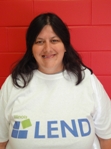How to Include Self-Advocates in Your LEND Program
October 15, 2010

|
| Tia Nelis |
Leadership Education in Neurodevelopmental and Related Disabilities (LEND) programs provide long-term, graduate level interdisciplinary training as well as interdisciplinary services and care. The purpose of the LEND training program is to improve the health of infants, children, and adolescents with disabilities. They accomplish this by preparing trainees from diverse professional disciplines to assume leadership roles in their respective fields and by insuring high levels of interdisciplinary clinical competence.
I became involved with IL LEND in the fall of 2010 as the first Self-Advocate LEND trainee. By being a part of LEND self-advocates have a chance to experience leadership in a new way. We learn about the medical part of disability, which you would not get a chance to learn from any other leadership training, and to see how other health professionals interact with people with disabilities. Self-advocates can learn a lot from the clinical experiences in the LEND program. While self-advocates may have significant knowledge of policy, leadership, and how to advocate for issues that may come up in legislation, we don't have as much experience in the clinical setting. LEND provides an opportunity to see this side of disability. This experience gives self-advocates a way to learn more about other disabilities than their own so when they work with other self-advocates they will know how to include and support them in other projects or groups they do.
LEND also gives the other trainees a chance to learn from the point of view of a person with a disability. A lot of what people know about disabilities comes from books, rather than first-hand experiences with people with disabilities. I think it is important for self-advocates to be involved in LEND to help provide the perspective of people with disabilities. This way self-advocates and students can learn together. Not only can self-advocates be teachers, but they can also learn from the other trainees and presenters.
Here is some advice on how to include self-advocates in your LEND program:
- First, believe that self-advocates can be LEND trainees.
- Value the viewpoint of the self-advocate, giving them the opportunity to present in class about disability issues and self-advocacy. They will give the other trainees the point of view of a person with a disability.
- Have supports in place, depending on the self-advocate's needs.
- Most importantly, ask the self-advocate what supports they would need and work with the self-advocate to develop them. For example, a mentor for the Family/Self-Advocacy discipline would be available to provide support to the self-advocate.
- Work with the self-advocate to develop a schedule for LEND that fits in well with the schedule for the other parts of their life.
- Check-in with the person regularly to make sure things are going well.
- It may be helpful to adapt the materials (e.g. large print text or materials with pictures or in audio form) according to the self-advocate's preferences.
- The self-advocate may need to go over the readings for class with someone to help interpret the medical and clinical terminology.
- Have someone available to accompany the self-advocate when they are doing observations for the class.
I hope other LEND programs will give self-advocates an opportunity to be a LEND trainee. Both self-advocates and other trainees learn from each other and are able to share their experiences with each other. LEND trainees are able to take what we learned, work together, and use that knowledge in the community to be more influential in changing policy and legislation. This will help make a better world for people with disabilities.







